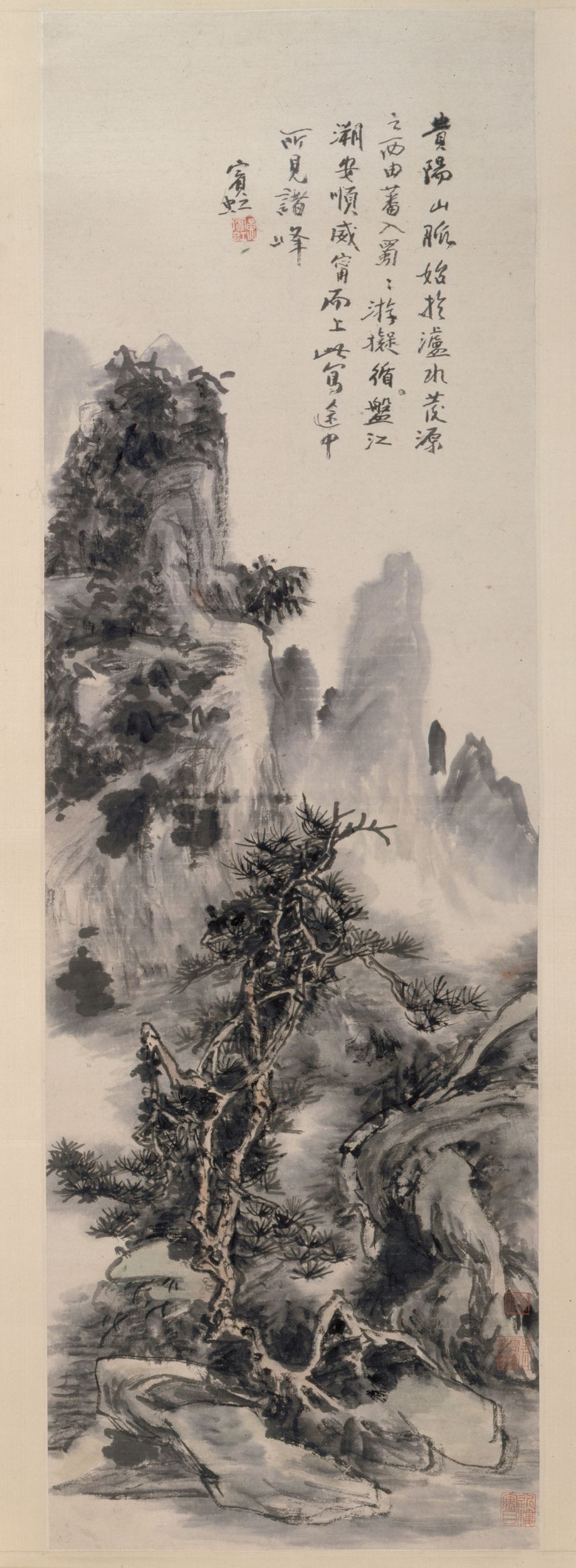
Paysage
Encre, Couleurs - Pigments, Papier
Peinture
黄賓虹; En bas à droite, sceau de collectionneur en caractère rouges « Kin-leou yu-mou »; Au-dessus, deux sceaux du peintre et collectionneur, élève de Houang Pin-hong, Chiang Er-shih (1913-1972) : « Ts’ing-chouang », son nom de pinceau "hao" : en caractère rouges « Ts’ing-chouang kouan tseu-wan » 青霜館自玩
Don manuel : Chiang, Er-shih
M.C. 9472
Inscription:
The Guiyang mountains start at the Lushui River [ ?] to the west of the spring, and cross Fan to enter the region of Shu [Sichuan].
Once in the region of Shu, I decided to follow the Pan River, heading upstream through Anshun, Weining and continuing upriver.
I have pictured here the summits I saw on the way. Binhong. Huang Binhong was born in Jinhua, Zhejiang. He spent his childhood near Shexian, in Anhui province, where his family came from. His traditional schooling, which prepared for the official government administration examinations, included the study of calligraphy, painting and seal carving. Huang Binhong had progressive ideas from an early age. He took part in the anti-Manchu movement and had to leave Anhui to take refuge in Shanghai in 1907. His artistic and critical activities developed within painter communities, such as the Society of Coldweather Friends, Hanzhiyou she, founded by Jing Hengyi and Chen Shuren. His work on traditional calligraphy and painting was closely associated with his editing activities. His most prominent contribution to this field would be the publication of the encyclopaedic work Meishu congshu. His authoritative knowledge of painting and calligraphy led him to take part in the authentication of works in the collection of the Palace Museum in 1936. Huang Binhong’s multidisciplinary activities, which included teaching, notably at the Beijing Academy of Fine Arts during the war years and in Hangzhou from 1948, as well as his writing and publications, would contribute to the emergence of art history in China.
His landscape paintings, nourished by his research, were mostly influenced by the works of Li Liufang (1575-1629), Cheng Sui (1607-1692), Kuncan (1612-1673) and Hongren (1610-1664), as well as the Song and Yuan masters. His landscapes were also inspired by his numerous travels. Among the last journeys he undertook were to Sichuan in 1933 and to Guilin in 1935. It was probably during the first of these two journeys that he made the boat trip enabling him to contemplate the mountains of Guizhou that he depicted in this painting. These landscapes inspired the works of the last twenty years of his life, which were also his most creative. Despite the precise geographical references mentioned on the work, the Cernuschi Museum landscape was painted from the artist’s memory, apparently in the 1940s.